By Apula Singh , Alumni of Vision India Foundation
The article was originally published in The Hindu
The source of this image is Vision India Foundation
East Delhi generates 2,000-2,200 metric tonnes of solid waste per day and this was the fifth time in the last two years that it was strewn over city streets. Safai-karamcharis first went on strike in March 2015. Another strike in January 2016 also saw the United Front of MCD employees join in. The reason: delay in salaries. But that’s not where it ends – it can be traced back to the trifurcation of the MCD.
Trifurcation was finalised in December 2011 and East MCD was constituted in May 2012. East MCD, with its headquarters in Patparganj Industrial area, has two administrative zones and 64 wards. The settlement types and the waste generated by them varies widely across wards. The day-to-day activities for solid waste management (SWM) are coordinated from the zonal offices and ward-wise staff is responsible for sweeping of roads, desilting of nallas up to 4 feet and garbage removal [requires removing, storing (in dustbin and dhalao), transporting via refuse-removal trucks to Ghazipur landfill].
Oddly, the zonal administration remains unchanged post-trifurcation. Only the very senior officials like Commissioners and Assistant Commissioners have increased but the number of junior staff from headquarters got divided into three. Thus, it was a highly centralised division as no rationalisation of staff requirements was done at the zonal or ward level. Since SWM is coordinated at the zonal level, an Administrative Officer exclaimed that ‘SWM process remained unchanged at ground level. Trifurcation’s effect was more on the administrative level – more additional commissioners, mayors.’
Read full article on The Hindu

